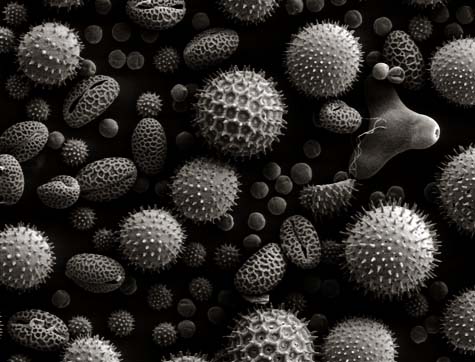 [Image: The internal structure of maple leaves, via Wikimedia].
[Image: The internal structure of maple leaves, via Wikimedia]. In 1997, Japanese composer Mamoru Fujieda released a CD called Patterns of Plants. The album featured "melodic material" that Fujieda developed using the "surface-electrical potential" of plant leaves.
In other words, he transformed leaves into sound.
You can hear excerpts from Patterns of Plants at the iTunes store.
Bear in mind, however, that you're not really listening to the electrical circuitry of amplified plantlife; the music is pretty stylized. We read, for instance, that every track combines "alternate tuning systems (just intonation, Pythagorean) with traditional instruments of China and Japan (sho, koto and the ancient 25-stringed zither, the hitsu)," creating a "bizarre and fascinating mixture of European Medieval music, the traditions of Asia and modern science."
In fact, Fujieda's musical translation of plantlife – sonatas encoded in cell structure and root – is similar to work done by composer Yuji Dogane. Dogane is known for creating a device called the Ecological Plantron. Dogane's Plantron "measures the minute electrical changes which flow across the surface of the leaves of plants, and changes them into sounds."
 [Image: A leaf, via Wikipedia].
[Image: A leaf, via Wikipedia].In any case, I was reminded of Fujieda's music today after reading a short article about the relationship between plantlife and sound in this week's issue of New Scientist.
There we read that Korean scientists "claim to have identified two genes in rice that respond to sound waves." These would be "sound-sensitive genes" – or "sound-responsive genes" – and they "could be attached to other genes to make them respond to sound too."
- The genes rbcS and Ald became more active at 125 and 250 hertz and less active at 50 hertz. As both are known to respond to light, the researchers repeated the tests in the dark and found that the two genes still responded to sound.
It's not photosynthesis, then, but audiosynthesis. Geneto-acoustic biology.
Even more interesting – and I absolutely love this:
- If the researchers are correct, they say their discovery could enable farmers to switch specific crop genes on and off, such as ones for flowering, by blasting sound into the fields.
Somewhere below, in a soundproof lab, scientists subject single seeds to six thousand hours of shifting frequencies, synthesizing vitamins, coaxing corn into wheat. It's industrial agri-alchemy.
You break-in, unaware of what the building really is, only to switch on your flashlight, terrified by the constant thunder, to see a thousand stalks of corn vibrating in rows all around you...
The ground is shaking and the air is full of pollen.
 [Image: Pollen, via Wikipedia].
[Image: Pollen, via Wikipedia].Will we grow tomorrow's crops inside recording studios?
Or, ten years from now, you stumble upon vast fields of barley stretching off to the horizon, and there are weatherproof speakers placed every three hundred feet, emitting F-sharp – though the exact sound they're playing has been patented.
You can hear the farm ten miles away.
Might sound – or infrasound – have as great an impact on genetic mutation as ultraviolet radiation from the sun?
 [Image: A field of barley, via Wikipedia].
[Image: A field of barley, via Wikipedia].And what of our genes, perhaps shaken into new configurations by exposure to the rarest of frequencies? Are we genetically affected by sound?
Further, might there be a civilization somewhere whose "music" is really a complicated form of genetic stimulation? For every concert you attend, you become something other – acoustically moving through new forms of alteration.
No comments:
Post a Comment